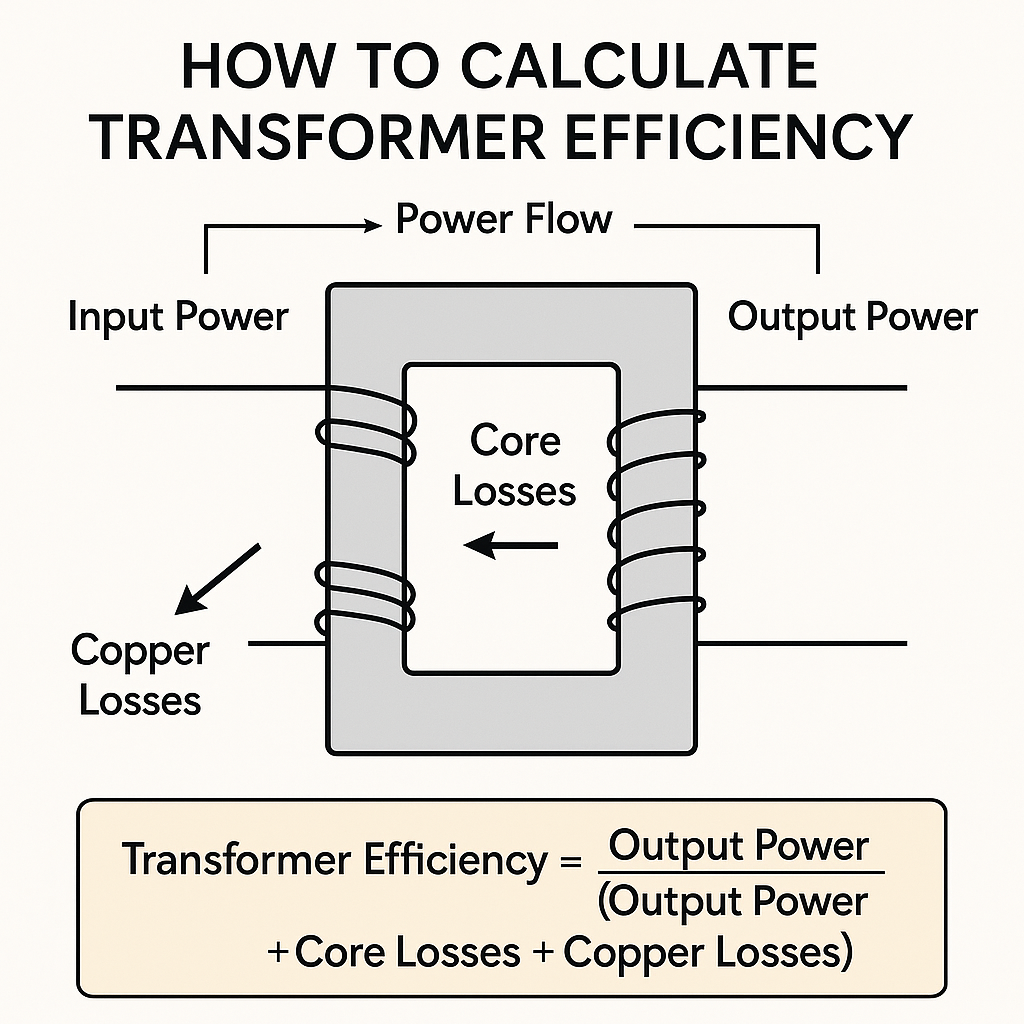
Introduction to Transformer Efficiency
Calculating transformer efficiency is more than a textbook exercise; it’s a critical practice in modern electrical engineering. At its core, transformer efficiency measures how effectively a transformer converts input power into useful output, with minimal energy lost as heat or stray losses. Accurate calculation ensures reliable operation, cost savings, and optimal performance.
Understanding the Basics of Transformer Efficiency
Transformer efficiency is the ratio of output power to input power, typically expressed as a percentage. Despite its simplicity, many engineers overlook real-world conditions that influence these numbers. This section demystifies those factors to help you better understand the efficiency equation.
What Does Transformer Efficiency Mean?
In simple terms, transformer efficiency shows how well a transformer performs under specific conditions. A perfectly efficient transformer (100%) would convert every watt of input power into output power. In reality, small amounts of energy are inevitably lost.
Why Transformer Efficiency Matters
Why should you care? Efficiency directly affects electricity bills, cooling requirements, and system reliability. A slight increase in efficiency can translate into thousands of dollars saved over a transformer’s lifespan.
Core Losses in Transformers
Core losses (also called iron losses) occur mainly due to hysteresis and eddy currents in the transformer’s magnetic core. These losses depend on voltage and frequency but remain relatively constant regardless of the load.
Copper Losses in Transformers
Copper losses arise due to resistance in transformer windings. Unlike core losses, they vary with the square of the load current. This makes load conditions critical when calculating overall efficiency.
Stray and Dielectric Losses
Although usually smaller than core and copper losses, stray losses (from leakage flux) and dielectric losses (from insulation) add up. Ignoring them can slightly skew efficiency calculations.
Load Conditions and Transformer Efficiency
Transformer efficiency isn’t static; it changes depending on load. Light loads often show lower efficiency due to relatively higher core losses, while heavy loads can increase copper losses.
How to Calculate Transformer Efficiency – Step-by-Step
Here’s a practical guide:
- Determine the transformer’s rated output (kVA or kW).
- Measure or find core losses (constant).
- Measure or find full-load copper losses.
- Identify the load factor (ratio of actual load to full load).
- Adjust copper losses by multiplying by the square of the load factor.
- Calculate input power: output power + total losses.
- Efficiency = (Output Power / Input Power) × 100%.
Transformer Efficiency Formula Explained
The classic formula is:

Where losses = core losses + copper losses.
Example: Calculating Transformer Efficiency
Consider a transformer with:
- Output: 100 kW
- Core losses: 1 kW
- Full-load copper losses: 2 kW
- Load factor: 0.8
Adjusted copper losses: 2 kW × (0.8)^2 = 1.28 kW
Total losses: 1 kW + 1.28 kW = 2.28 kW
Input power: 100 kW + 2.28 kW = 102.28 kW

Practical Considerations in Efficiency Calculation
Real transformers operate under fluctuating loads, voltage variations, and temperature changes. So, measured efficiency can differ slightly from calculated values.
All-day Efficiency vs. Maximum Efficiency
All-day efficiency is used for transformers operating under varying loads (like distribution transformers). It considers energy over 24 hours rather than peak efficiency at full load.
Impact of Load on Transformer Efficiency
Higher loads increase copper losses, lowering efficiency. Light loads make core losses more dominant, also reducing efficiency. The ideal efficiency often occurs at a specific load.
Temperature Effect on Transformer Efficiency
As temperature rises, winding resistance increases, raising copper losses and reducing efficiency. Proper cooling and design help mitigate this.
Tips to Improve Transformer Efficiency
- Use low-loss core materials.
- Optimize winding design.
- Keep transformers properly loaded.
- Maintain good ventilation.
Using Simulation Tools to Estimate Efficiency
Software tools (like ANSYS, MATLAB) simulate transformer behavior, offering accurate efficiency estimates under different operating conditions.
Common Mistakes in Calculating Transformer Efficiency
- Ignoring stray and dielectric losses.
- Using nameplate values without adjustments.
- Misapplying load factors.
Transformer Testing Methods for Efficiency
Two main methods:
- Open-circuit and short-circuit tests.
- Direct loading test (less common for large units).
Real-world Challenges in Measuring Efficiency
Measuring small differences between large input and output powers requires precise instruments. Errors can distort results.
Future Trends in Transformer Design and Efficiency
New materials, advanced cooling, and digital monitoring promise higher efficiency and smarter operation.
Case Study: Transformer Efficiency in Industry
In manufacturing, even a 1% efficiency gain can save significant annual energy costs, reduce heat load, and extend equipment life.
Transformer Efficiency in Renewable Energy Systems
Efficiency is especially vital in solar and wind systems where every watt counts towards greener power.
FAQs on How to Calculate Transformer Efficiency
What is the typical efficiency of power transformers?
Large power transformers often achieve 98–99% efficiency.
Does transformer size affect efficiency?
Yes. Larger transformers tend to be more efficient due to lower relative losses.
Can efficiency exceed 100%?
No. That would violate the laws of physics.
How do temperature and humidity impact efficiency?
Higher temperature raises copper losses; humidity can cause insulation deterioration.
Are there losses other than core and copper?
Yes. Stray and dielectric losses, though smaller, still matter.
When should I recalculate efficiency?
After repairs, modifications, or significant load changes.
Conclusion: The Importance of Accurate Efficiency Calculation
Knowing how to calculate transformer efficiency isn’t just an academic skill—it’s a practical tool for saving energy, reducing costs, and improving system reliability.

- how to calculate transformer efficiency
- IEEE, NEMA standards
- (no title)
- Proven 7-Step Guide to Calculate Transformer Efficiency
- Grounding vs Bonding Differences
- How to Size a Circuit Breaker: 7 Pro Tips to Avoid Dangerous Overloads
- Setting Up Your Blog (Domain, Hosting, Design)
